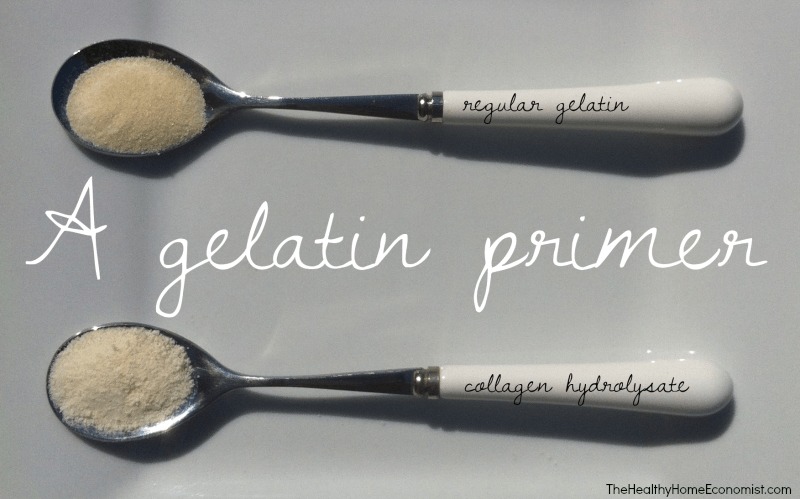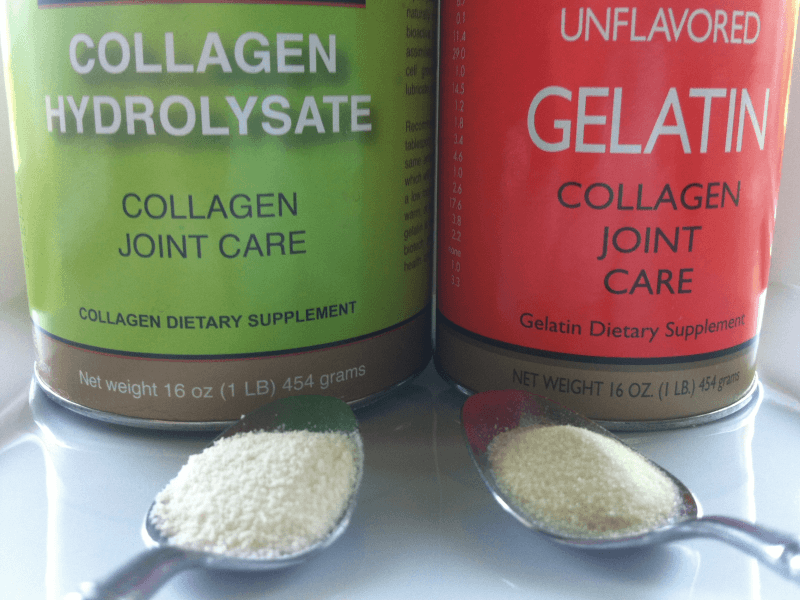The important differences between collagen hydrolysate (peptides) and gelatin, and a comparison of both to identify which one is better for anti-aging, cooking and overall health.

Gelatin (also known as cooked collagen) is a wonder food with anti-inflammatory and anti-aging qualities, as it helps to fill in the missing amino acids (the building blocks of proteins) in the standard American diet.
According to Ray Peat, Ph.D., “The degenerative and inflammatory diseases can often be corrected by the use of gelatin-rich foods” (1).
One of the greatest benefits of using gelatin is to help balance our amino acid intake. Because collagen makes up approximately 50% of the whole animal, gelatin can be used to help create a more complete protein balance in our diet. The standard American diet tends to be very high in muscle meats (such as beef, chicken, lamb, and turkey), which when not balanced by other proteins (such as eggs, fish, dairy, shellfish, organ meats) can contribute to inflammation over time (2).
The benefits of gelatin are many as it has a unique and very non-inflammatory amino acid profile, primarily consisting of glycine, glutamic acid, proline, and alanine (tryptophan and several other amino acids are completely missing).
Although these are non-essential amino acids (meaning your body can make them), many malnourished and over-stressed livers are not able to manufacture all the non-essential amino acids in the amounts demanded by the body. The liver needs an abundance of these proteins to keep functioning optimally, particularly to fuel phase 2 detoxification. This helps your body detox or “take out the trash” in our toxic world, reducing inflammation!
Gelatin versus Collagen Hydrolysate

Although the most nutrient-dense source of gelatin is homemade bone broth (since it contains minerals as well), powdered versions offer a more convenient way to consistently get it into your diet.
Processing
I spoke personally with the president of a company that produces collagen and gelatin to get the low down on exactly how collagen hydrolysate (also called hydrolyzed collagen) and gelatin are processed.
According to this reputable source, the company uses grass-fed beef hides for the raw material for their bovine products. The split hides (under the hair where the collagen lies) are put into an alkaline solution and held for a number of days where the material is broken down into smaller pieces of skin.
Next, it’s acid back washed and pumped into cooking kettles which separate tallow, skin, and collagen. The collagen is then filtered and put through a vacuum evaporator at 212 degrees F (a very delicate process). After evaporation is complete there is a four-second sanitation process at 240F degrees that kills any unwanted bacteria. At this stage, it is classified as pure collagen.
Collagen hydrolysate (quality sources): The collagen is stored in a holding tank at a higher temperature to reduce the molecular weight cleaving the amino acid bonds. This process is called hydrolysis. At the appropriate time, it is then introduced to the spray dryer whereas the product is made into a dry powder.
Gelatin (quality sources): The collagen is sent to a votator, chilled and solidified, pumped onto a drying belt, and is now considered gelatin. It is dried to under 12% moisture, milled to a granular specification and packaged.
How to Best Use Each Type of Collagen
Collagen hydrolysate – The hydrolysis process described above renders the gelatin powder more easily digestible and appropriate for those with digestive weakness and sensitivity. I find this type of gelatin best used as a protein powder with careful dosing (see Important Note below).
Mix collagen hydrolysate in drinks, shakes, smoothies, ice cream, or add a tablespoon to your favorite recipe to give it an anti-inflammatory protein boost. It will dissolve in cold liquids easily.
Having collagen hydrolysate with a meal that contains muscle meat can help balance the amino acid profile that enters your bloodstream. “If a person eats a large serving of meat, it’s probably helpful to have 5 or 10 grams of gelatin at approximately the same time, so that the amino acids enter the bloodstream in balance.” Ray Peat, PhD. (3)
Gelatin – Regular gelatin is only hot water-soluble and best used to create foods that gel (fruit snacks, healthy jello, homemade marshmallows, desserts, etc).
How Much Do You Need?
Individual needs will vary, but most people can start off with about ½ -1 tablespoon per day of collagen hydrolysate (either as powder or capsules), and increase by 1 tablespoon every two weeks or so as tolerated.
According to Ray Peat Ph.D., gelatin can make up about 30% of total protein intake, which for the typical person is about 3-6 TBL of gelatin per day (1 tablespoon of gelatin is 6 grams of protein).
Contraindications
Remember not to get too carried away with either gelatin or peptides. Adding too much too quickly can cause digestive issues: bloating, loss of appetite, stomach ache is just a few side effects.
It’s important to remember that more is not always better, especially if you are adding it to your diet for the first time.
Gelatin should be used in addition to a nutrient-dense diet and not to replace real food like homemade bone broths and grass-fed meats.
Where to Find the Best Collagen and Gelatin
Perfect Supplements and Radiant Life are the only two companies that currently offer a quality source of both collagen and gelatin that is gently manufactured and third-party tested/certified for purity (no glyphosate residue risk!).
These quality protein supplements blend easily into the beverage, smoothie, or food of your choice. Choose between grass-fed collagen, and gelatin both available in large, economical canisters.
Marine collagen is also an option for those fish-eating vegetarians.
This supplement is also available in very convenient Type II collagen capsules. This is a great option for traveling.
References
Great Lakes FAQ
Gelatin, stress, longevity by Ray Peat
More Information
The Reason You Need More Gelatin in Your Diet
5 Reasons Your Stock Won’t Gel
Bulletproof Coffee (even with added peptides) Shoots You in the Foot








Scleroderma is an autoimmune condition where I’m making to much collagen. Digestion is also affected and I want to have bone broths for that. What’s your view on it affecting my collagen In a negative way?
Started using Collagen Peptides by Vital Proteins about 2 mos. ago. After about 2 weeks started feeling
very positive affects such as increased energy and improved feeling from my teeth, hair and vision. After using 2/20 oz. containers my knee became swollen and very painful. Also my leg became swollen from my knee to my ankle. This followed by a gout attack in my toe joint in the other leg. After seeing my DR. and taking meds I am feeling much better. Was wondering if taking a Marine Collagen could possibly help to avoid the reaction I had from a bovine product made in Brazil or maybe you could suggest something else. Would like to continue the initial positive affects I experienced. Your feed back would be appreciated.
Hi Mark,
I recently had a similar experience after taking collagen protein for the last month and a half (1 TB/day). I had an episode of gout in my big toe joint. When I looked at the normal causes of gout, nothing matched for me, except the addition of this new protein to my diet. Have you discovered anything new regarding the correlation between the collagen protein and your gout since you wrote your post here? Any advice would be most helpful. Thank you!!
Ditto Angie! Do not eat anything that roaches have access to, they carry so many germs. An air tight container is another remedy, but I’d move too.
I just made my first bone broth from chicken feet I got from US Wellness. It doesn’t take all that ‘chicken-y’ but it gelled up really really well. Do I need to have other bones as well for a chicken flavor or are my taste buds fried from years of what I THOUGHT was chicken flavored but probably had no actual chicken in it? I am finding it hard to drink. I heated it back up and added carrots, celery and chicken from a rotisserie chicken I bought at Fresh Market, but I is still kind of bland. Any suggestions on what I can add to it?? Thanks so much!
We always season ours with a good quality sea salt and freshly ground pepper. Makes a world of difference!
Hello. Thanks for this information. I just bought Great Lakes Collagen and am looking forward to positive results. We grow our own root parsley and root celery and have always added this to all soups- the whole plant, and it really adds amazing flavor to all soups. I recommend: http://www.rareseeds.com for organic, non gmo, heirloom seeds.
Also sold in stores as parsnips, I believe. enjoy!
Salt and pepper, for sure. Try cooking minced garlic in olive oil until it starts to turn light brown, add salt, and drizzle over the broth.
Also, thanks for this post, Catharine! Very informative.
Thanks for this article. I bought collagen but thought I ordered gelatin. So when I realized it I looked it up and found this.
Would the collagen even gel or no?
Also, I made some bone broth from lamb bones that even included some of the joints and I used a few chicken feet. But it is not gelling when refrigerated. Do lamb bones not gel? I’m thinking also I may have used too much water. Could that prevent it from gelling also?
the hydrolisate will not gel.
I would like to make home made broth, but its impossible to find a grass fed meat in NYC.
All i can see is grain feed. WHat to do?
whole foods sells grass fed beef and it is excellent
Hello,
Whenever I consume my homemade bone broth, I get diarrhea. I’m not sure what causes this. Do you think taking a supplement like the Great Lakes gelatin or a collagen supplement will affect me the same way. I don’t want to invest in another product that I can’t return. Does anyone have any thoughts on this?
You can try cooking the broth for a shorter time. I used to get diarrhea and headaches from a long cooked bone broth. After I cut back the cooking time to 3-4 hours I was able to drink it
you can also try making broth with just the meat, not the bones. Also try starting with only 1/4 cup a day and working your way up slowly. Same with the gleatin if you try it – start with 1/4 tsp and work up.
Also, can this be mixed into a protein powder or meal with protein, or best eaten alone?